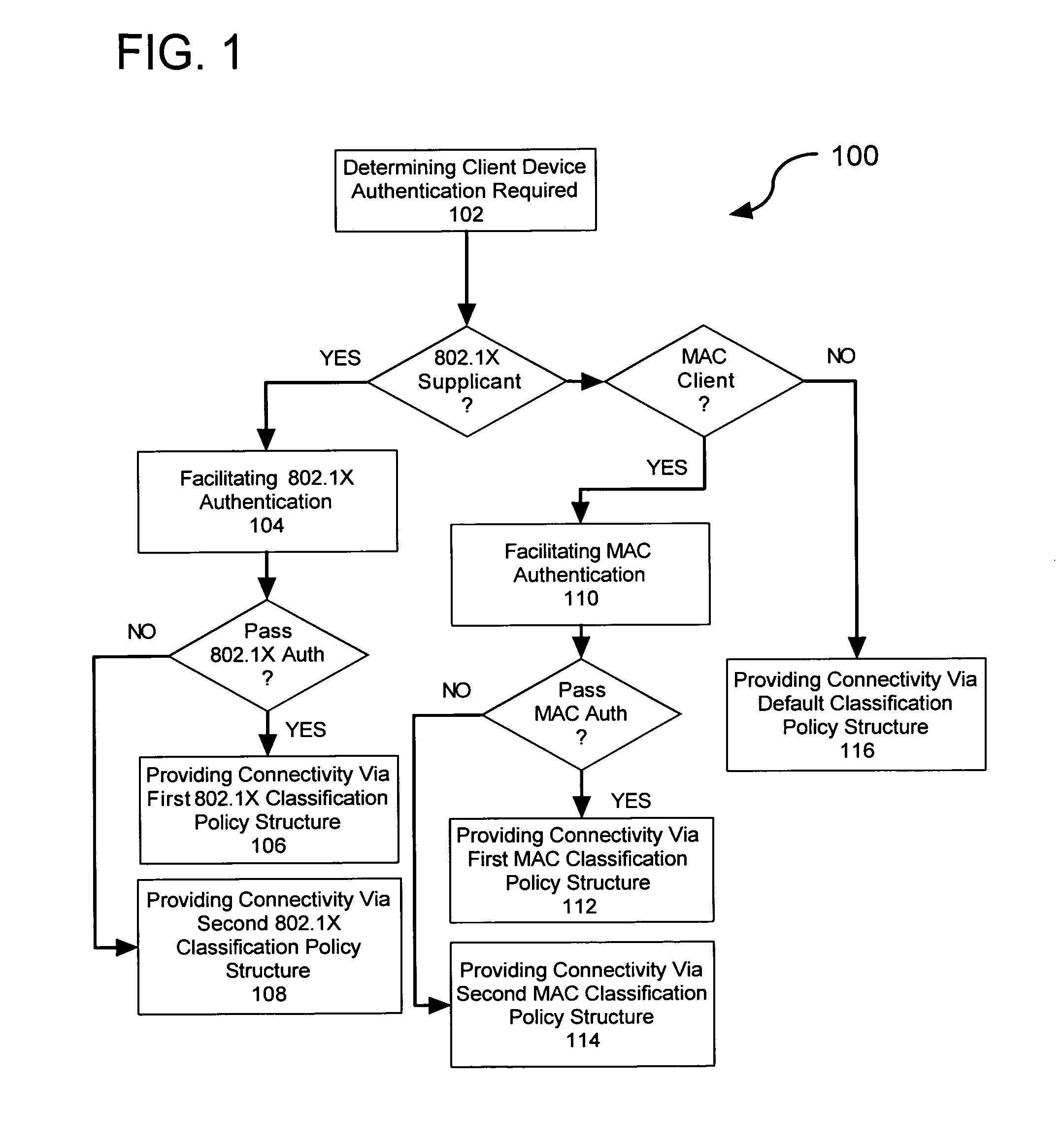Facilitating heterogeneous authentication for allowing network access
a network access and heterogeneous authentication technology, applied in the field of facilitating heterogeneous authentication for allowing network access, can solve the problems of inability to provide such advanced and flexible methodologies in the field of prior art solutions, and achieve the effect of reducing operational overhead and increasing the ability to identify
- Summary
- Abstract
- Description
- Claims
- Application Information
AI Technical Summary
Benefits of technology
Problems solved by technology
Method used
Image
Examples
example 2
[0069]Command is 802.1x slot / port non-supplicant policy authentication vlan 10 default-vlan, which sets policies for non-supplicants. The policy treats tagged and non-tagged frames differently.
[0070]In the non-tagged case, as shown in FIG. 16, MAC authentication is performed first. If the device passed authentication, but could not be classified, then its MAC is learned on VLAN 10, provided that the latter VLAN exists. If VLAN 10 is not configured then the device's MAC is learned on the default VLAN of the port. If the device failed the authentication it is blocked. It should be noted that, if the keywords ‘pass’ and ‘fail’ are omitted, it is assume that the chain is related to the ‘pass’ case, whereas, for the ‘fail’ case, it is assumed the default terminal policy (Block).
[0071]In the tagged case (not specifically shown), MAC authentication is performed first. If the device passed authentication and the VLAN is returned then the device is classified only if the VLAN exists and matc...
example 3
[0073]Command is 802.1x slot / port non-supplicant policy authentication fail vlan 100 default-vlan, which sets policies for non-supplicants. MAC authentication is performed first. The policy treats tagged and non-tagged frames differently.
[0074]In the non-tagged case, as shown in FIG. 17, MAC authentication is performed first. If the device passed authentication, but is not classified, then its MAC is blocked. If the device fails authentication, then its MAC is learned on VLAN 100, provided that it exists and is not an authenticated VLAN. Otherwise, the device's MAC is learned on the default VLAN of the port if that VLAN is not an authenticated one. The device's MAC is blocked otherwise.
[0075]In the tagged case (not specifically shown), MAC authentication is performed first. If the device passed authentication and the VLAN is returned then the device is classified only if the VLAN exists and matches the tag VLAN. Otherwise the device is blocked. If the device fails authentication, th...
example 4
[0076]Command is 802.1x slot / port non-supplicant policy authentication pass vlan 10 block fail group-mobility default-vlan, which sets policies for non-supplicants. The policy treats tagged and non tagged frames differently.
[0077]In the non-tagged case, as shown in FIG. 18, MAC authentication is performed first. If the device passed authentication, but is not classified, then its MAC is learned on VLAN 10, provided that the VLAN exists. If the VLAN is not configured then the device's MAC is blocked. If the device fails authentication, VLAN classification rules are applied. If no rule matches, or the related VLAN is an authenticated one then the device's MAC is learned on the default VLAN provided that the latter VLAN is not an authenticated one. The device's MAC is blocked otherwise.
[0078]In the tagged case (not specifically shown), MAC authentication is performed first. If the device passed authentication and the VLAN is returned then the device is classified only if the VLAN exist...
PUM
 Login to View More
Login to View More Abstract
Description
Claims
Application Information
 Login to View More
Login to View More - R&D
- Intellectual Property
- Life Sciences
- Materials
- Tech Scout
- Unparalleled Data Quality
- Higher Quality Content
- 60% Fewer Hallucinations
Browse by: Latest US Patents, China's latest patents, Technical Efficacy Thesaurus, Application Domain, Technology Topic, Popular Technical Reports.
© 2025 PatSnap. All rights reserved.Legal|Privacy policy|Modern Slavery Act Transparency Statement|Sitemap|About US| Contact US: help@patsnap.com



